Schedule Weekly | Number of issues 666 | |
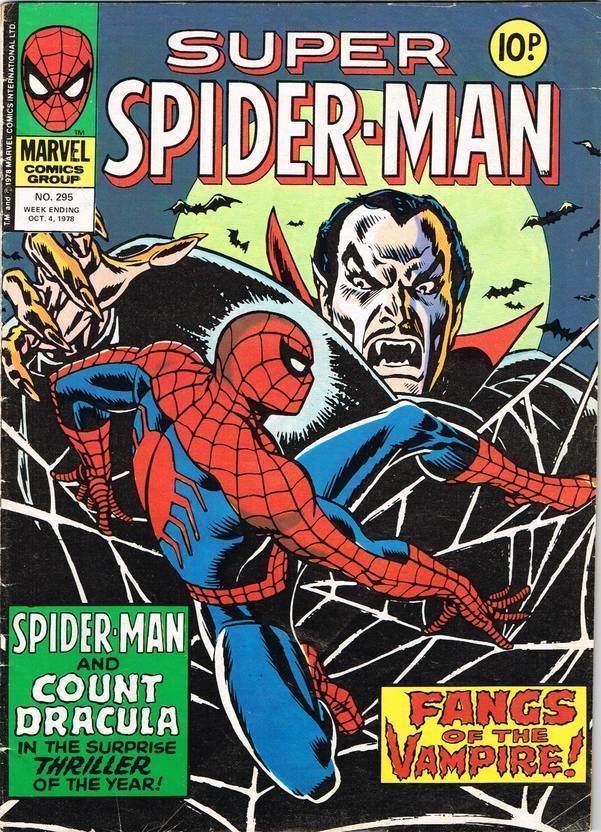 | ||
Publication date Feb. 10, 1973 - Dec. 1985 Similar The Amazing Spider‑M, The Mighty World of Marvel, The Superior Foes of S, Marvel Age, Ultimate Comics: Spider‑Man | ||
Spider-Man Comics Weekly was a Marvel UK publication which primarily published black-and-white reprints of American Marvel four-color Spider-Man stories. Marvel UK's second-ever title, Spider-Man Comics Weekly debuted in 1973, initially publishing "classic" 1960s Spider-Man stories (as well as Thor backup stories).
Contents
- Publication history
- Spider Man Comics Weekly
- Super Spider Man
- Spider Man Comic
- Spectacular Spider Man Weekly
- Spider Man and Hulk Weekly
- Super Spider Man TV Comic
- Spider Man and His Amazing Friends
- The Spider Man Comic
- Spidey Comic
- Annuals and specials
- Spider Man and Zoids
- The Complete Spider Man
- The Exploits of Spider Man
- The Astonishing Spider Man other Panini UK titles
- References
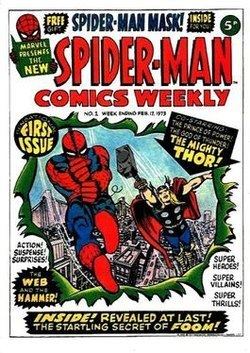
The title proved to be a great success. Along with Marvel UK's flagship title, The Mighty World of Marvel, Spider-Man Comics Weekly helped Marvel gain a foothold in the (at the time) vast UK weekly comic market, allowing the company to cross-market and later introduce non-superhero UK-reprint titles such as Planet of the Apes and Star Wars.
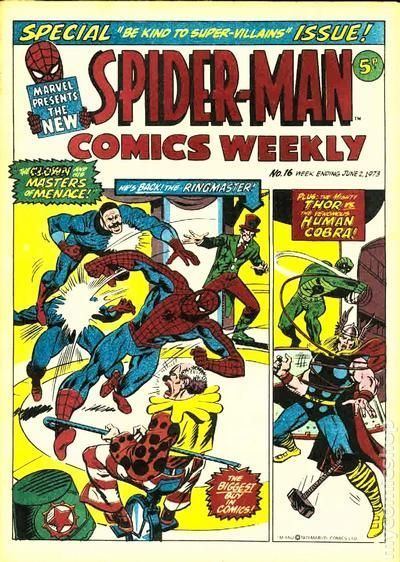
Although it changed its title name several times over the years (mostly due to other less successful Marvel UK comics merging with it), the Spider-Man weekly comic eventually became the longest-running Marvel UK publication, publishing 666 issues from 1973-1985.
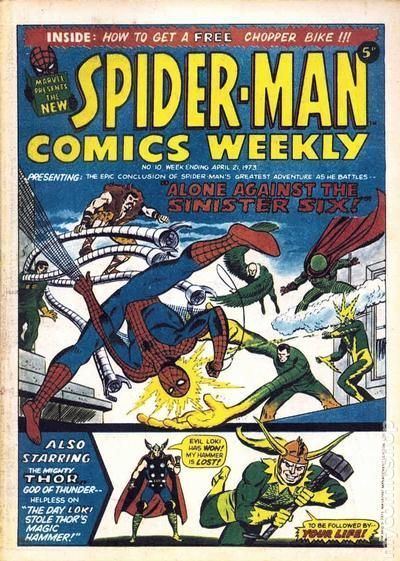
Publication history
During the course of its run, the book was successively known in the indicia as:

Spider-Man Comics Weekly
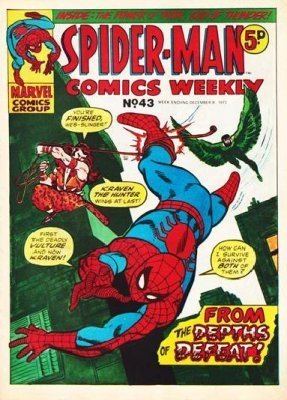
Due to the character's popularity in Marvel UK's first title, The Mighty World of Marvel, Spider-Man was made the star of his own weekly comic in early 1973. The monthly format of the American source material was adapted to fit the British weekly format, with stories being split up over several weeks. The backup strip featured Thor reprints, with Iron Man joining him from issue #50. The first issue also promoted the UK branch of Marvel's new in-house fan club, FOOM.
Super Spider-Man
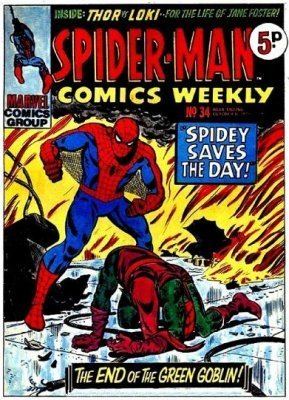
In early 1976 the short-lived Marvel UK title The Super-Heroes was merged into Spider-Man Comics Weekly, which at that point changed its title to Super Spider-Man with the Super-Heroes. The book also changed orientation to become a landscape-format comic, following the lead of another relatively new Marvel UK title, The Titans. Although this format allowed two pages of Marvel US artwork to fit onto one (magazine-sized) Marvel UK page, reader reaction was mixed, as it made the text small and often difficult to read.
In addition to the continuing stories of Spider-Man, Thor, and Iron Man, Super Spider-Man with the Super-Heroes started out with X-Men backup stories. It soon, however, continued The Super-Heroes comic’s tradition of rotating less-popular characters like Doctor Strange, Tales of Asgard, and Moon Knight; before settling with The Invaders. Also from The Super-Heroes came reprint stories from Marvel Two-in-One starring the Thing, which had been running in later issues of the comic before the merger (as well as Spider-Man stories from Marvel Team-Up).
In late 1976, the Spider-Man weekly comic absorbed another cancelled Marvel UK title into its pages: The Titans. Following the precedent of the earlier merger with The Super-Heroes, with issue #199 the book changed its title again, to Super Spider-Man and the Titans. A line-up of Spider-Man, Thor, Iron Man, Invaders, Captain America, and the Avengers meant that some weeks Captain America appeared in three different strips. The book continued using the landscape orientation until the penultimate edition of Super Spider-Man and the Titans (#229), when it reverted to the traditional "portrait" format — just in time for the next merger.
In 1976 Marvel UK had debuted its first original weekly series, starring the homegrown British superhero Captain Britain. Captain Britain Weekly lasted 39 issues, to July 6, 1977. With Super Spider-Man's July 13, 1977, issue, #231, it absorbed Captain Britain Weekly and changed its title again, to Super Spider-Man & Captain Britain.
The title's main features were now black-and-white reprints of stories from the American The Amazing Spider-Man comic, with new eight-page black-and-white Captain Britain stories, continuing from the cancelled Captain Britain solo comic. Super Spider-Man and Captain Britain lasted 22 issues; the highlight of the run was the six-issue finale (issues #248-#252), written by Chris Claremont with art by John Byrne, featuring both Spider-Man and Captain Britain, and the debut of the villain Arcade. (The storyline originated in Marvel Team-Up #65 & #66.)
As well as Spider-Man and Captain Britain, Thor and the Avengers continued from Super Spider-Man and the Titans while the Fantastic Four joined from Captain Britain weekly, only to depart after a few months to headline their own comic, The Complete Fantastic Four. With issue #254 (Dec. 21, 1977), the Captain Britain feature was dropped and the Captain America stories continued; the book's title became simply Super Spider-Man, retaining that name until issue #310.
Spider-Man Comic
In 1978, British editor Dez Skinn was hired by Stan Lee to take over the now ailing Marvel UK. Skinn revamped all of Marvel UK's titles, including Super Spider-Man. He changed the title to Spider-Man Comic and gave it a new look, more similar to the outward appearance of "traditional" British comic books. Although original US artwork was reprinted, as in previous publications, panels were often chopped up, re-arranged, removed or reduced in size to meet the lower page count.
In addition to Spider-Man, the title featured five backup strips, starring the Fantastic Four, the Avengers, Thor, the Sub-Mariner, and Nova. (The Avengers went on to become the longest-running backup series in the weekly Spider-Man comic.)
Spectacular Spider-Man Weekly
The summer of 1979 saw the demise of the weekly comic formerly known as The Mighty World of Marvel (changed since the Skinn era to Marvel Comic), and the cancelled weekly was merged into Spider-Man Comic. The new title was called The Spectacular Spider-Man Weekly and Marvel Comic for three issues, and then reverted to the shorter Spectacular Spider-Man Weekly for the rest of its 41 issues. Backup stories now featured Daredevil (who moved over from the defunct Marvel Comic), but no longer included the Avengers (who moved to the new Marvel UK monthly title, Marvel Superheroes Monthly).
Spider-Man and Hulk Weekly
The Hulk was another Marvel character with great popularity in the UK. After co-starring for many years in the pages of The Mighty World of Marvel, the green goliath was given his own weekly title, Hulk Comic, in 1979. However, with the May 1980 cancellation of Hulk Comic after 63 issues, it was merged into the Spider-Man title, which became Spider-Man and Hulk Weekly from issues #375–449. Backup stories featured the two main characters' female counterparts, Spider-Woman and She-Hulk, as well as The Defenders (which was continued from Hulk Comic). Spider-Woman and The Defenders were later replaced by Spider-Man team-up stories and Showcase (a strip that spotlighted superheroes who had not had a solo strip before) after the Marvel Team-Up UK weekly merged with the Spider-Man weekly comic. The cover initially indicated the merger by being titled Spider-Man and Hulk Weekly Incorporating Marvel Team-Up, but this was later abbreviated to Spider-Man and Hulk Team-Up.
Super Spider-Man TV Comic
The 1977–1979 The Amazing Spider-Man live-action television series inspired yet another title change, in October 1981; the Spider-Man weekly also changed to more of a magazine format, with photo essays, reader comments, contests, and the like (as well as the obligatory reprints of Marvel US material). The format also changed to 28 pages with 8 pages of colour - a marked difference to others titles when almost all UK comics were still black and white except for their covers and perhaps the centre spread. The colour pages were printed on a glossier paper. Only the Spider-Man strip ran during these issues.
Spider-Man (and His Amazing Friends)
With issue #500, the title changed its name again, to just Spider-Man, with the page count now increased to 36. Back-up stories returned, as well; initially this was the Hulk following the merger of the second volume of The Incredible Hulk Weekly into Spider-Man. Spider-Woman backup stories returned with issue #517 and the Fantastic Four returned in issue #529.
The debut of the animated series Spider-Man and His Amazing Friends (1981–1983) on BBC One inspired the latest title change in October 1983. The logo remained the same, but the words "and His Amazing Friends" were added around it. Initially the back-up strips were an adaption of the first episode of the cartoon (co-starring Iceman and Firestar) and the continuing Fantastic Four strips. Later these were replaced by Thor, and the X-Men from issue #567 (Jan. 1984). With issue #578, the title again reverted to Spider-Man and eventually began continuing stories from the short-lived Marvel UK title The Thing is Big Ben (referring to Ben Grimm, a.k.a. The Thing).
Issues #607–#610 featured original Spider-Man stories by Mike Collins and Mark Farmer. The stories took place in London and featured Spider-Man battling Assassin-8.
The Spider-Man Comic
At the time, in late 1984, the British audience for the comic was skewing younger, just as the readers of the American Spider-Man comics were skewing older. With issue #631, the series began reprinting stories featuring Spider-Man's controversial black costume, and fearful of losing readers, Marvel shortly thereafter stopped running reprints of the American material. Initially the title reprinted Spider-Man stories from give-away issues in US newspapers — starting with the 1983 Spider-Man, Firestar and Iceman comic from the Denver Post — but shortly after these stories were replaced with tales for younger readers from the pages of the American title Spidey Super Stories, backed up by strips such as Wally the Wizard — renamed Willy the Wizard for the UK — and Fraggle Rock from the Marvel US children's imprint Star Comics. These were supplemented by short comedy strips by Lew Stringer, such as Snail-Man. Later issues also featured reprints of the two-page The Dukes of Hazard strip from TV Comic coinciding with repeats of the TV series being aired in the UK.
Spidey Comic
With the August 1985 name change to Spidey Comic, the title solidified its targeting of younger children. Finally, in December 1985, the Spider-Man weekly published its last issue, #666.
Annuals and specials
Even after the demise of Spider-Man Comics Weekly, Spider-Man annuals continued to appear on a yearly basis, continuing from their 1974 debut through 1986, and then from 1990–1992, with a Spider-Man and Hulk Omnibus annual in 1983. Spider-Man Summer Specials were published from 1979–1987, and Winter Specials from 1979-1985. A Spider-Man Holiday Special was published in 1992.
Marvel UK published 28 issues of a digest-sized book titled Spider-Man Pocket Book between March 1980 and July 1982. Following that title's cancellation, the early Spider-Man stories it was then reprinting continued for a few months in the pages of the short-lived Marvel UK title The Daredevils.
Spider-Man and Zoids
On March 8, 1986, Marvel UK launched a new Spider-Man reprint weekly comic, called Spider-Man and Zoids, with new numbering. In a link with Spider-Man Comics Weekly, Spider-Man and Zoids was described as "volume 2". The only original material featured the Zoids, a tie-in with the toys of the same name. Spider-Man and Zoids was notable for featuring early work by Grant Morrison, including the epic and apocalyptic Black Zoid storyline. The new title lasted only 51 issues until February 16, 1987.
The Complete Spider-Man
Marvel UK tried other vehicles for Spider-Man, including 1990's The Complete Spider-Man (a US-comic-sized monthly reprinting material from the American monthlies running at the time: Spider-Man, Amazing Spider-Man, Spectacular Spider-Man and Web of Spider-Man). The Complete Spider-Man was launched shortly after the first issue of Todd McFarlane's adjectiveless Spider-Man title in the US.
The Exploits of Spider-Man
The Exploits of Spider-Man was a UK-comic-sized monthly featuring current Spider-Man stories, classic Spider-Man stories, Spider-Man 2099 and Motormouth reprints.
The Astonishing Spider-Man & other Panini UK titles
As from issue six of The Astonishing Spider-Man, all of Marvel UK's titles were acquired by Panini UK, which now holds the license to publish comics under the Marvel name in the UK. Panini UK added several biweekly and monthly titles, including The Spectacular Spider-Man (for younger readers), Ultimate Spider-Man (later Ultimate Spider-Man and X-Men after a merger), and Spider-Man and Friends (for very young readers). The Spectacular Spider-Man, was launched to accompany Spider-Man: The Animated Series, which began broadcasting in the UK in the mid-90s. Initially, the stories were simply reprints of the US comics based on the series, but eventually the title moved to all-new UK-originated stories, marking the first Marvel UK material featuring classic Marvel characters to be produced since early 1994.
